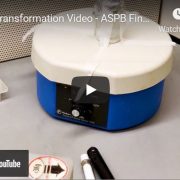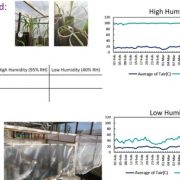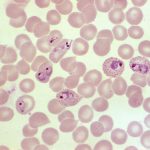The War on Viruses: Insights from the Front Lines
Alex Clarke Conviron Scholars 2019 Final Project
I was interested in the opinions of professors and researchers on the current state of the field of plant virology, including the future directions it may take and the most important technologies in the field. I also wished to learn what system they work on and how they got into the career they are in now. Finally, I wanted to hear directly from researchers in the field of plant virology why studying plant viruses is important and how their research impacts the general public. My goal is for this simple survey Q&A to introduce scientists and non-scientists alike to a field of plant research that they may be unfamiliar with. Hopefully, readers take away from this some information about plant viruses as well as the knowledge that researchers are approachable and happy to chat about their science!
What follows are the answers to seven questions that I posed to plant virologists at various institutions across the US. Participants include four university faculty and one researcher at a USDA-ARS site. Locations range from Missouri to Florida to New York.
Major takeaways:
- 4/5 virologists named Potato virus Y (or the virus family Potyviridae that it is a member of) as one of the most important plant viruses
- 4/5 virologists got their start in the field of plant virology through their experiences in undergraduate education
- 5/5 virologists agree that research in the field of plant virology has a positive impact on the average person in one way or another
Please enjoy your read of the survey responses below, and consider reaching out to a plant virologist or other scientist near you to find out more about their work!
Marc Fuchs
- What is your current position/institution? Professor at Cornell University
- What system do you work in and why? Viruses of fruit and vegetable crops
- When were you first interested in plant viruses and how did you get to the position you are in today? My interest in and passion for plant viruses was inspired by instructors when I was an undergraduate student. I got my current position because several mentors and colleagues put confidence in me.
- In your opinion what are the three most important plant viruses? Tomato yellow leaf curl virus, cucumber mosaic virus and potato virus
- What is the most important technique or technology in the field? It is a combination of different systems biology approaches (transcriptomics, proteomics, large scale sequencing, etc.) substantially impacts the field these days
- How do you think the field will grow and change over the next 10-15 years? Advancing our understanding of the interactome of viromes/plant hosts/insect vectors will lead the field in the next decade
- How does research into plant viruses impact the average person? Efforts to take out plant viruses from the agriculture production and food processing systems impact the average person
Anonymous Assistant Professor
- What is your current position/institution? Participants would prefer to remain anonymous.
- What system do you work in and why? Potyviridae family, which have very unique leader sequences necessary for driving translation and a great system to study the breakdown of resistance. These types of viruses are similar in genome organization and strategy to virus pathogens that afflict vertebrates, so that our findings may also apply to a variety of devastating diseases plaguing humans.
- When were you first interested in plant viruses and how did you get to the position you are in today? As a MS student working on the role of the small viral encoded ORF 6 protein of Barley yellow dwarf virus, with Dr W.Allen Miller at Iowa State University, Ames IA.
- How did I get to the position where I am today? Serendipity
- In your opinion what are the three most important plant viruses? [T]he ones that I work on? I guess the most important plant viruses should be the ones that have a clear economical impact/ and/or real threat to food security, clear obstacles in controlling them. I would say Potato virus Y . cassava mosaic virus complex, .[H]mm can’t come up with a 3rd one
- What is the most important technique or technology in the field? [I] think right now it is the large scale genomic RNA-protein binding interactome. [A]nother one would be ribo-seq
- How do you think the field will grow and change over the next 10-15 years? Microbiome is expanding [sic] for fungi/bacteria. and viruses haven’t caught up yet in the field would further explore into how viruses are influencing other microbes, the use of microphage for dealing with antibiotic resistance, …
- 7. How does research into plant viruses impact the average person? I guess I would tell an average person that detection of some plant viruses is now used as a test for human fecal contamination of water source…
Footnote: Brackets are used in places where capitalization was not used, and to replace emoji use
Jim Schoelz
- What is your current position/institution?
- Professor and Director of Graduate Studies
- Division of Plant Sciences
- University of Missouri
- What system do you work in and why?
- Cauliflower mosaic virus/Nicotianas for host range, crucifers and Arabidopsis. Why this system? I am fascinated by the multifunctional nature of plant virus proteins. Plant viruses have a very small genome size – the CaMV genome encodes only six proteins and somehow with this limited repertoire it has to infect its host. The CaMV P6 protein sets up a “virion factory” in the cell and we are continually learning new things about where this factory is localized in the cell and how it functions. I was a co-author on a CaMV P6 paper in 1984 and will be publishing another paper on P6 this year.
- Tombusviruses/characterization of R/Avr interactions in Nicotiana. Why this system? The genus Nicotiana is great for understanding how plants recognize and defend against virus infections. There is a well-developed phylogeny for the ~76 Nicotiana species and if I had the money and time, I would characterize all of the R gene/virus effector interactions that exist in Nicotiana, which would likely tell us how R genes evolved to target viruses for resistance.
- Tobacco mosaic virus/Nicotiana. Why this system? TMV is a great tool for teaching concepts about viruses. I use TMV for a number of labs in Intro Plant Path, including movement of TMV-GFP in N. benthamiana, host resistance, detection of viruses, and purification of virions.
- Grapevine viruses/hybrid grapes. Why this system? I recently completed a survey for viruses in the hybrid grape varieties grown in Missouri and it turns out that the great majority of samples we tested were infected with multiple viruses, even though most of the varieties never exhibited symptoms. This survey illustrates what can happen with viruses in a perennial crop when no one is monitoring for virus spread. I now see that there is a need to characterize viruses in the hybrid grapes grown in the middle of the U.S. (as opposed to Vitis vinifera grown on the coasts) and more importantly, to examine the impact of these viruses on grape quality.
- When were you first interested in plant viruses and how did you get to the position you are in today? As an undergraduate, I started out working with bacteriophages and really did not know anything about plant viruses at that time. My only plant course as an undergrad was Introductory Botany. When I started looking for graduate schools, I considered medical microbiology as well as plant virology. I became interested in CaMV when I visited UC Davis and talked with Bob Shepherd, who became my graduate advisor. He was telling me about this virus (CaMV) that could be cloned in infectious form into bacterial plasmids and then reintroduced into plants, so you could do all sorts of things with the viral DNA. This was 1981, recombinant DNA was a new thing (hard to believe but true), and CaMV was the only infectious clone at the time. I thought, “this seems pretty cool” and decided to join his lab. I was actually the first person to make gene swaps between infectious clones of a virus to identify a virus gene that triggered HR. Right place, right time. I really liked my project. Bob relocated from UC Davis to the University of Kentucky and I went with him, finishing my PhD in 1986. When I finished my PhD I had two options for postdocs; I could have gone to work at Monsanto or gone to Cornell to work with Milt Zaitlin. Well, Milt was kind of my hero, because he was an author on all of the papers I was reading, so my wife and I moved to Ithaca. I was a postdoc at Cornell with Milt for a year, and it was during this time that I met Peter Palukaitis. However, I also wanted to get a real job, so I applied for my current job at the University of Missouri. This was the only place where I interviewed. I think I was offered the job at MU because 1) my initial project with Shepherd was really good, 2) Bob must have written me a really nice letter, and 3) the Chair of Plant Pathology at Kentucky was friends with the Chair of Plant Pathology at MU. Connections help. The startup package I was offered exceeded my expectations, and so I started as an Assistant Professor at MU in 1987 and I stayed.
- In your opinion what are the three most important plant viruses? I think you could go with Barley yellow dwarf, Cucumber mosaic virus, Tomato spotted wilt, and collectively the Potyviruses (I realize that that is four). However, the answer is going to vary, depending on the crop. From a grower’s perspective, the three most important plant viruses are the ones that are going to affect their crops.
- What is the most important technique or technology in the field? I think a standard answer would be some variation of PCR. However, on a more fundamental level the most important technology is sequencing coupled with computing. I was lecturing on plant viruses last week and it struck me how the nature of diagnostics has changed from the beginning of my career to the present. When I [was a] graduate student, we were taught that virologists kept a series of 10-20 indicator plants and one aspect in the initial characterization of a suspected virus disease would be to see how the indicated plants responded to inoculation. Now, you can just bypass all of that by isolating total RNAs, sequencing the small RNA fraction and BLASTing the results against the database of known viruses. That will pretty much tell you what you are dealing with.
- How do you think the field will grow and change over the next 10-15 years? I think it is important to first consider the arc of plant virology that I witnessed from 1981 to the early 2000’s. I started my career at the beginning of what I consider the “Virus genome sequencing project”. In the early 80’s whole papers were published on the sequence of RNA 2 of Cucumber mosaic virus, and the nucleotide sequence of CaMV (all 8031 bp) was published in Cell(!). Infectious clones were developed in the 80’s for a number of viruses and this revolutionized how plant virology was conducted. The research in a lot of virus labs was largely organized around either a single virus or a small number of viruses in a family, and a lot of the basics of plant virology were established (i.e what is the genome size of a virus?, what is the primary function of each of the virus proteins?, where are these proteins found in the cell?, how does a virus move? etc). During this period, virologists were very successful in characterizing the primary functions of virus proteins, and I think that one thing that happened is that the plant biology community sort of said, “OK, we have figured out viruses, let’s move on to more complex organisms like bacteria and fungi.” There was a general acceptance that virus proteins were multifunctional but this subject has not been fully explored. By contrast, transformation systems have matured for bacterial and fungal organisms, which really opens up the types of experiments that could be conducted. In the 2000’s the competition for Federal grants became really fierce even as the amount of money available for research stagnates. I used to track the budgets allocated to plant pathology research that were published for NIFA for a number of years, and the amount of money available in that program could only fund a fraction of the grants that deserved to be funded.
- So, where will plant virology go over the next 10-15 years? It is going to be really tough to make a living as a virologist interested in the basic biology of virus infections. There are going to be some really cool stories that won’t be told because the grants were never funded by USDA or NSF. The virologists that survive will largely be found in states that have strong commodity programs for plant pathology research and the research will be tied to those viruses in that are clearly shown to extract an economic cost to production. This base of commodity support will allow those virologists to successfully apply for Federal funds.
- How does research into plant viruses impact the average person? In the United states we have been very successful in creating an environment where the impact of plant virus diseases is kept to a minimum. I am thinking about all of the regulatory work that goes into the development of virus-free crops, as well as the basic research necessary for the initial characterization of the virus that led to the diagnostic tests. Sure, plant viruses can cause localized epidemics, but I would be hard pressed to point to anything sold in the grocery store in the U.S. and say that a virus disease could lead to the elimination of that item. The two transgenic virus-resistant crops sold in the U.S. are largely invisible to most consumers. Transgenic papaya is only sold in the [sic] Hawaii and perhaps on the west coast. It is not sold in the Midwest- I know, I have looked for it in grocery stores here. I have also not seen an update on the adoption of transgenic virus-resistant squash in many years, so I have no idea if any squash sold in Missouri is transgenic. In a similar fashion, all of the work that goes into breeding for resistance or into strategies to manage the spread of virus diseases in crop plants is equally invisible to the average person. The impact of virus research is that the average person can buy high-quality food for a very low price and never have to think about plant viruses.
Scott Adkins
- What is your current position/institution? Research Plant Pathologist (Virologist) U.S. Department of Agriculture, Agricultural Research Service U.S. Horticultural Research Laboratory Fort Pierce, FL 34945
- What system do you work in and why? Wide range of domestic, exotic and emerging virus diseases of major horticultural crops nationally and internationally. Most efforts are focused on vegetable and ornamental crops. Within vegetables most efforts are focused on solanaceous (tomato, pepper) and cucurbitaceous (watermelon, squash, cucumber) crops. These are major food crops worldwide, and economically important at local, state, national and international levels. The principal virus groups studied are tospoviruses, ipomoviruses and tobamoviruses.
- When were you first interested in plant viruses and how did you get to the position you are in today? Undergraduate research in plant virology during school year and internships over summers. Mentorship by virology leaders.
- In your opinion what are the three most important plant viruses? Tobacco mosaic virus Tomato spotted wilt virus Potato virus Y
- What is the most important technique or technology in the field? Sequencing/bioinformatics
- How do you think the field will grow and change over the next 10-15 years? Continuous discovery of new virus species through sequencing/bioinformatics. Broad availability of rapid in-field diagnostic tests for virus identification to species level.
- How does research into plant viruses impact the average person? Keeps them fed three times a day with plentiful, nutritious, and sustainable plant products.
Christina Rosa
- What is your current position/institution? Assistant Professor, Penn State
- What system do you work in and why? I work mainly on tospoviruses because they are an economic problem in Pennsylvania; and on Ourmia melon virus because it represents an excellent tool for discovery molecular mechanisms underlying virus/plant interactions. I work on other virus systems as well, if there is a need.
- When were you first interested in plant viruses and how did you get to the position you are in today? During my undergrad I completed an internship in a plant virology lab in Australia. There is where I got my first exposure to plant viruses. My current position was opened when a plant virologist working in my department decided to retire, and my department decided to invest again in plant virology.
- In your opinion what are the three most important plant viruses? Viruses in the Orthotospoviruses and geminiviridae are extremely damaging worldwide.
- What is the most important technique or technology in the field? Today cryoelectromicroscopy, superresolution microscopy, proteomics and metabolomics. More traditional techniques that are still extremely usueful are classical molecular biology techniques, including the ones used to make and deliver infectious clones.
- How do you think the field will grow and change over the next 10-15 years? Hopefully we will be able to study the spatio-temporal dynamics of viral infections, and to link them with other factors (microbial and environmental) contributing to plant health.
- How does research into plant viruses impact the average person? In the US the average person probably is not aware of the impact of plant viruses, but everybody is indirectly involved in sustaining the costs of plant viruses quarantine, eradication, crop losses etc. Did you know that one of the fees paid at airports and included in the cost of flight tickets goes to APHIS, to test for viruses in imported plant material? In countries where the economy is based on agriculture and the average person is a grower, plant viruses cause direct economic losses that are much more evident to the average person than in the US.










Leave a Reply
Want to join the discussion?Feel free to contribute!